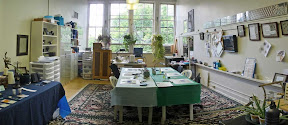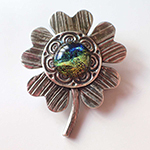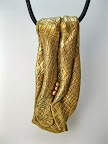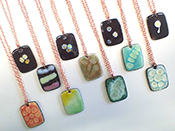
On Saturday I taught for the first time at the newly-relocated Mars Beads. It’s a great space, lots of room, and owner-Carolyn has a wide selection of reasonably-priced beads. (If you want the more unique — and pricier — stuff, your choices are somewhat limited here. If you want a good deal on a good intermediate-level selection (that, say, you can use to enhance a major focal piece without pricing it out of range) then Mars Beads should definitely be on your shopping list.)
The class was on how to make a reversible hollow “lentil” bead. I think that’s a good class for a number of reasons: it covers a lot of the basics of working with metal clay that are applicable to a number of other projects; and you come out of it with a unique piece that is reversible, so it’s almost like you are getting two different pieces for the (not inexpensive, I know) price of one.
Since there are lots and lots of little details to keep straight as you’re starting out, I’m happy if it’s a relatively small class. That way, I have a better chance of being able to give everyone the individual attention they need. In describing the class to potential students, there was the photo of four sample pieces shown above, plus I left a selection of about seven or eight pieces at Mars Beads for a month prior to the class.
Below is one piece I constructed while doing in-class demos. It is not quite as “polished” (in either design or finish) as some of my other pieces, but it illustrates what I think a typical student should be able to do in an introductory session. (Some will do even better, more like some of my other pieces, but everyone should be able to achieve this.)
It covers rolling, texturing, and cutting the clay. Cleaning up edges in the moist-clay state. Cutting holes versus drilling them. Making, shaping, and attaching appliques. Working with little coils and balls of clay for decoration. A little bit of each basic activity.
Although I try to teach using methods that reduce or eliminate the need for sanding dry clay, hollow beads like these are among my few exceptions: we do sand to get the edges down to a “knife edge” before attaching the two separate sides to each other. While doing that sanding, I talk casually but deliberately about safety issues, especially those related to eating, absorbing, or breathing any of the materials students will be working with. I am not a “purist” who insists that “all sanding is bad” but do tell cautionary tales, urging people to realize that every act of sanding should be a deliberate choice, best taken only when no other option exists, and should then be done with care and adequate precautions.
As I’m both sanding and talking about that, I carefully pass each half of the bead around the room several times, asking people to identify when it has been sanded “enough.” I also pass around samples with sharp versus rounded edges where the pieces were attached. I find it interesting how different people react quite differently to that whole part of the session.
Well, on Saturday I had one student who did an absolutely perfect job of identifying when my sample pieces were and were not adequately sanded, and of picking out the samples that corresponded to stopping at various stages along the way. But when she went to do her own bead, of course, she happily moistened her clay and stuck the pieces securely together and then asked, “Now what do I do about all these gaps and ridges?” Aack! Her edges were nowhere near ready to have been stuck together yet, and way too lumpy to resolve by more sanding at that point. All of that should have been handled before attaching the pieces. And, yes, she had done a wonderfully good job of getting them stuck together.
Soooo, the workaround we came up with was to roll out a “string” of clay and use that to surround the piece. We pushed the bottom of it down into the gaps while trying to keep the outside nicely rounded. (Aside from the poor quality of the lighting in the photos I snapped quickly before giving the final result back to this student) how do you think that idea worked out? What else might we have done?

 Artsmiths of Pittsburgh
Artsmiths of Pittsburgh Hoyt Center for the Arts, New Castle, PA
Hoyt Center for the Arts, New Castle, PA Portage Hill Gallery, Westfield, NY
Portage Hill Gallery, Westfield, NY _Open Houses in my Studio
_Open Houses in my Studio _Or…contact me about hosting a private party!
_Or…contact me about hosting a private party!










